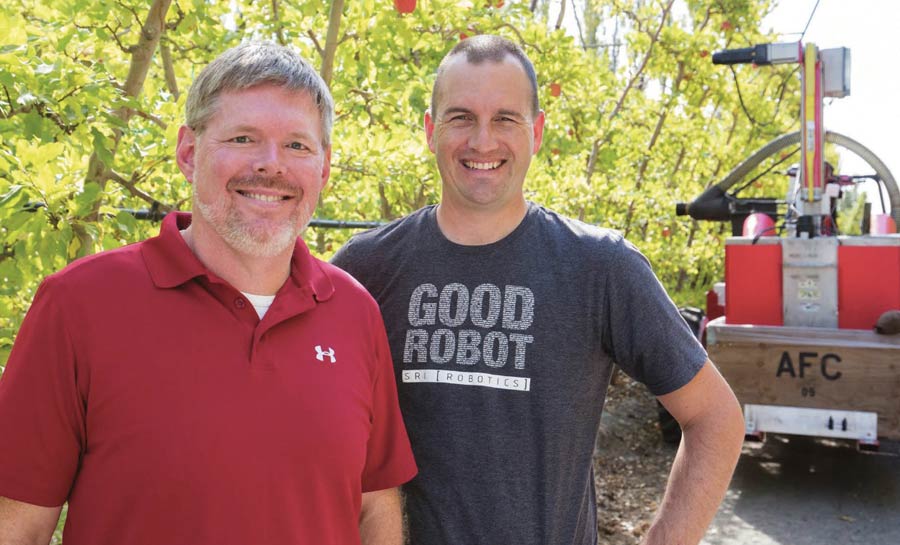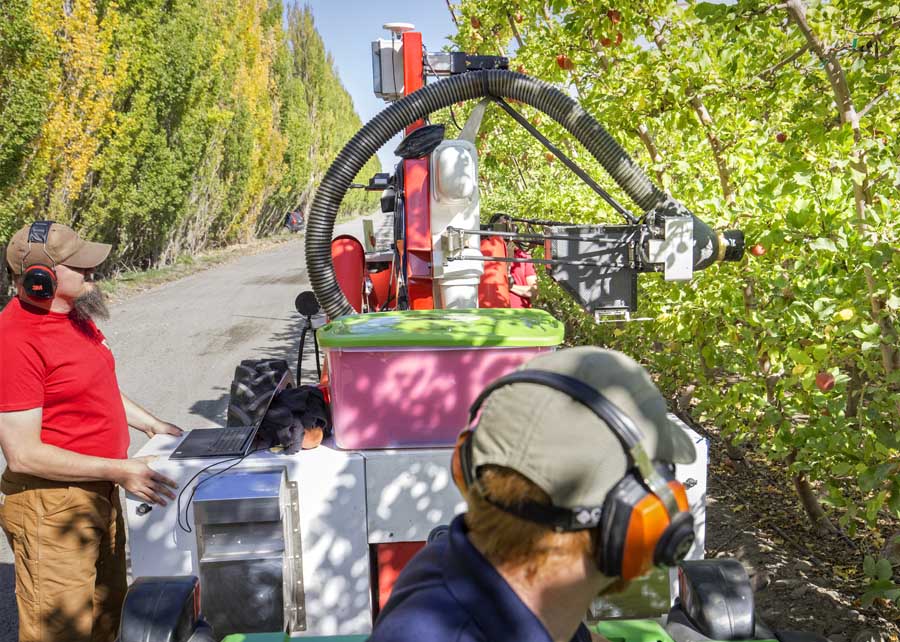
Dan Steere, left, and Curt Salisbury, co-founders of Abundant Robotics Inc. (TJ Mullinax/Good Fruit Grower)
A vacuum apple harvester under development by a California company has shown it can see the apples, pick them from the tree and do so without causing significant damage to either at a picking rate of faster than one apple per second.
Now that researchers have proven the technology works, their focus is to engineer a machine that will operate effectively in today’s orchards and can be easily integrated with other orchard systems. Their goal: have the first machines available for commercial use in 2018.
“There’s a lot of work to be done to build the product, but there comes a time in research and development where you switch from technology research to good producing engineering, and we’ve reached that point,” Abundant Robotics CEO Dan Steere told Good Fruit Grower. “We recognize it needs to lower the cost per pick, and we expect this will do so substantially.”
Researchers at Abundant Robotics, a spinoff of SRI International, began work to develop an automated harvester three years ago, with trips to orchards in Washington state and the Southern Hemisphere to test their prototypes during harvest.
In trials last year, they found that the vision system and vacuum picker were capable of recognizing, localizing and picking apples without bruising them, at a picking rate of faster than one apple per second.
However, the machine remained parked, picking in place, the optical sensor showed room for improvement, and the machine’s workspace needed to be expanded to reach more of the canopy.
Multiple changes to hardware and software in the ensuing months resulted in additional advances in orchard trials this year, both in Australia and Washington.
Fine-tuning the equipment

Operators of an Abundant Robotics automated vacuum harvester monitor the test vehicle working a Fuji apple block during the 2016 Washington apple harvest. (TJ Mullinax/Good Fruit Grower)
For their trials, the researchers thinned apples to singles, as well as to those they considered physically inaccessible to the robot, such as those immediately behind the trunk.
They also pruned the tree to 10 inches beyond the trellis wires to create a fruiting wall.
To allow the machine’s vision system to better recognize fruit on the tree, they moved the camera to the end-effector itself.
In a prepared canopy of Pink Lady apples 10 feet tall with 10 feet between rows, they found the machine recognized 92 percent of apples distributed across three wires at different heights — 30 inches, 46 inches and 62 inches from the ground.
Detection rates varied across wires, with 79 percent of apples detected on the lowest wire, followed by 94 percent and 97 percent on the second and third wires.
The poorer sight for the bottom wire was attributed to foliage blocking the picker’s vision, which could be corrected by scanning further below the bottom wire, Curt Salisbury, lead researcher and Abundant’s chief technology officer, told members of the Washington Tree Fruit Research Commission at an August meeting.
The robot’s blind spots were directly behind the wire and behind the trunk, and it picked 99 percent of the fruit it saw. “If we saw it, we picked it,” Salisbury said.
In addition, the researchers expanded the workspace of the robotic arm to 51 inches diagonally and 20 inches deep, which enabled the machine to pick apples between 24 inches and 57 inches above the ground, however Steere commented that a commercial system would have a much larger reach.
They also continuously picked while moving down a row using a tractor with a minimum forward speed of .05 mph, or about .8 inches per second, when put in lowest gear and with an engine speed of 1,200 rpm.
The speed was varied by the tractor driver based upon the apple load in the canopy to maintain the desired average pick rate of one apple per second, with an average travel rate down the row of between 1 and 6 inches per second.
In fall 2015, a trial picking of 180 Fuji apples had a cull rate of 14 percent, largely due to punctures and cuts on the fruit.
In spring 2016, a trial picking of 200 Pink Lady apples resulted in a reduced cull rate of nearly 11 percent, largely due to bruising.
Punctures were eliminated by better preparing the canopy, Salisbury said, and some of the bruises, which occurred on a more bruise-prone variety, were caused by changes to the vacuum system that will be corrected in future iterations of the prototype.
There were only a couple of instances where spurs were picked, and the number of stem pulls also was quite a bit smaller and has been found to be variety specific.
Recommendations
Many growers are already asking what they should be doing to prepare for automation.
For its part, Abundant Robotics isn’t prepared to start offering growers recommendations for orchard specifications just yet — or provide details about how the system might be rolled out commercially or at what cost — but the team has been able to answer a number of questions about use in different orchard systems.
The machine’s ability to pick has been the same in both vertical and angled canopies, and trained canopies will have better results with the robotic picker, Salisbury said.
“There are a few benefits that come from that. One is that all of the fruit tends to be close to one another along that plane, so the amount of motion and resulting movement time you have to go through to transition from one set of apples to another tends to be shorter,” he said.
Additionally, he said, longer growth tends to obstruct the machine’s ability to get into the canopy and increases the propensity for pulling in a branch and bruising or puncturing the fruit.
Steere agreed. “We’re very comfortable at this point that tightly trained canopies are going to be necessary for automation,” he said. “The specifications for that, we’re not ready to put a hard stake in the ground, but a lot of this work is pointing to tightly trained canopies enabling this type of automation.”
Going forward, as they continue work to advance the robotic harvester toward commercialization, the researchers also are working on engineering the prototype to work in conjunction with a conveyance system.
– by Shannon Dininny






Good story .
Please can we get the telephone number for abundant robotics?
Thanks